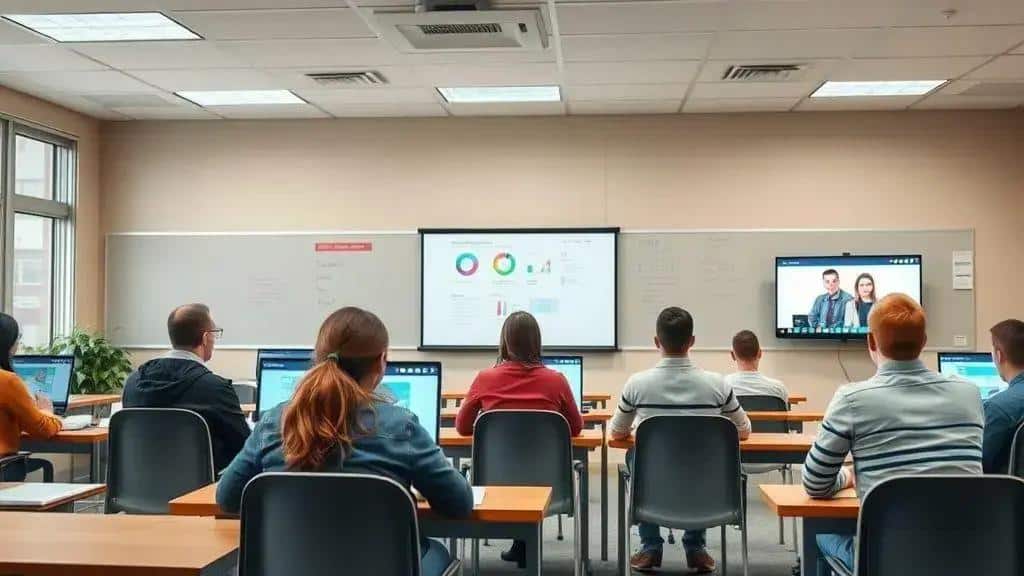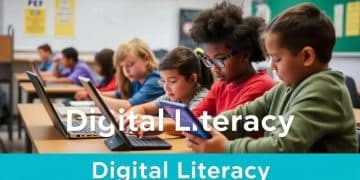Benefits of hybrid learning in universities you shouldn’t miss

The benefits of hybrid learning in universities include enhanced flexibility, improved student engagement, and the ability to cater to diverse learning styles through both online and in-person instruction.
Benefits of hybrid learning in universities are becoming increasingly clear in today’s educational landscape. This approach not only offers flexibility but also caters to diverse learning styles, engaging students like never before. Curious about how it works? Let’s dive in!
Enhancing student engagement in hybrid learning
Enhancing student engagement in hybrid learning is vital for achieving educational success. With a blend of in-person and online methods, universities can create a vibrant learning environment that keeps students interested and motivated. Understanding the best ways to boost engagement can transform the learning experience.
Active Participation
One significant way to enhance engagement is through active participation. When students interact actively with the content and each other, they feel more connected to their learning journey.
- Incorporating group discussions during online sessions.
- Using interactive polls to gather student feedback.
- Implementing breakout rooms for focused collaboration.
These techniques make learning more dynamic and foster a sense of community among students.
Utilizing Technology
Another key aspect is utilizing technology effectively. Tools such as forums, chat applications, and educational software can facilitate better communication. When students can ask questions and share ideas freely, their engagement levels increase significantly.
- Encouraging the use of discussion boards for class topics.
- Allowing students to create video presentations to share their work.
- Fostering online quizzes to make learning fun.
Such methods not only keep students engaged but also promote collaboration and learning from peers.
Furthermore, integrating multimedia resources into hybrid learning can captivate students’ attention. Videos, podcasts, and interactive simulations cater to different learning styles, making the material more relatable and accessible.
It’s essential to provide feedback regularly to maintain engagement. Students benefit from knowing how they are progressing, and timely feedback helps them stay on track and feel valued. This connection between instructors and students is crucial for fostering an engaging atmosphere.
Overall, enhancing student engagement in hybrid learning involves a mix of strategies that emphasize participation, technology, and tailored feedback. By creating an interactive and supportive environment, universities can help students thrive academically.
Flexibility: a key advantage of hybrid education

Flexibility is a key advantage of hybrid education, allowing students to learn in ways that best fit their individual needs. This model combines both in-person and online learning, providing options that traditional classrooms often cannot offer. For many students, this flexibility can lead to enhanced learning experiences.
Adaptable Scheduling
One of the most significant benefits is adaptable scheduling. Students can attend classes when it works for them, making it easier to balance education with other responsibilities, like work or family.
- Students can choose to participate in live classes or watch recorded sessions later.
- Assignments can often be submitted online, making deadlines easier to manage.
- This flexibility reduces stress and allows students to learn at their own pace.
When students can customize their learning schedules, they are more likely to engage with the material and stay motivated.
Personalized Learning Environments
In addition to adaptable schedules, hybrid education offers personalized learning environments. Students can create a space that works best for them, whether it’s at home, in a library, or on campus. This customization enhances comfort and can improve focus.
Moreover, hybrid education often includes diverse learning resources, from videos to interactive modules. This variety can cater to different learning styles, making education more accessible for everyone. For example, some students might grasp concepts more quickly through visual aids, while others prefer practical activities. By having access to various materials, all students can find what suits them best.
Furthermore, the ability to toggle between online and in-person learning helps accommodate lifestyle changes. If a student needs to adapt due to health issues or other personal matters, hybrid education ensures they can continue their studies without significant interruptions.
Overall, the flexibility of hybrid education allows learners to shape their educational journeys to suit their needs, leading to higher satisfaction and better academic performance.
Balancing online and in-person learning
Balancing online and in-person learning is crucial for maximizing the effectiveness of hybrid education. This combination allows students to enjoy the benefits of both environments, leading to a richer educational experience. By understanding the balance needed, institutions can enhance learning outcomes.
Finding the Right Mix
To achieve a balanced approach, universities must determine the optimal amount of time students spend in both settings. Some courses might be better suited for in-person interaction, while others could thrive in an online setting. This flexibility allows instructors to tailor their teaching methods based on the subject matter.
- Courses that require hands-on activities, such as labs, are often best delivered in person.
- Discussion-based classes can be effectively held online, using forums and video calls to facilitate conversation.
- Guest lectures and expert panels can be integrated into in-person sessions to enrich the learning experience.
When educators consider these factors, they can create a curriculum that leverages the strengths of both platforms.
Encouraging Student Engagement
Another important aspect for balancing these learning modes is promoting student engagement. In-person classes provide opportunities for immediate interaction and feedback, while online platforms offer the chance for reflection and deeper analysis. Balancing their usage encourages students to participate actively in their learning.
Students can engage through:
- Online group projects that can be presented in person.
- Live Q&A sessions following online lectures to clarify complex topics.
- Peer reviews conducted online, leading to in-person discussions about feedback.
By blending these opportunities, students are more likely to be motivated and achieve their academic goals.
Additionally, providing various assessment methods can cater to different strengths. For instance, some students may excel in written assignments online, while others might prefer speaking presentations in person. This adaptability can greatly enhance overall student satisfaction.
Challenges and solutions in hybrid learning environments

Challenges and solutions in hybrid learning environments are critical for universities seeking to provide effective education. While this model offers great flexibility, it also presents unique obstacles that instructors and students must navigate. Understanding these challenges is the first step toward finding effective solutions.
Technological Issues
One common challenge is the reliance on technology. Students and instructors need stable internet access and reliable devices to participate successfully. Without these, the learning experience can suffer. Many students might face issues with low bandwidth or lack of adequate hardware, making it difficult to engage fully in online components.
- Providing tech support for students can help alleviate concerns.
- Institutions should offer loaner devices for those in need.
- Facilitating workshops on tech use can empower users.
Addressing these issues ensures everyone has the tools needed for success.
Engagement and Interaction
Maintaining student engagement can also be a challenge in hybrid settings. Often, students attending classes online may feel isolated and less motivated to interact. This lack of engagement can impact their learning and overall performance.
To combat this, educators can implement several strategies:
- Incorporating interactive activities like polls and discussions during live sessions.
- Creating smaller groups for breakout discussions to enhance interaction.
- Utilizing forums for peer-to-peer support and conversation.
These approaches can help foster a sense of community and encourage active participation, regardless of where the students are located.
Additionally, instructors must adapt their teaching methods to cater to diverse learning environments. Using varied materials and modalities can help engage students in different ways. Providing options, such as recorded lectures, allows students to revisit complex topics at their own pace, which can be particularly beneficial.
Training faculty members to navigate hybrid teaching effectively is also vital. Continuous professional development ensures educators are equipped to handle both virtual and face-to-face interactions.
In conclusion, hybrid learning offers significant advantages, such as flexibility, engagement, and personalized education. However, challenges like technology issues and maintaining interaction must be addressed effectively. By embracing innovative solutions and adapting teaching methods, universities can enhance the hybrid learning experience for all students. This approach not only supports student success but also prepares them for future challenges in their academic journeys.
FAQ – Frequently Asked Questions about Hybrid Learning in Universities
What are the key advantages of hybrid learning?
Hybrid learning offers flexibility, allowing students to learn at their own pace while combining online resources with in-person interaction for a richer experience.
How can universities address technological challenges in hybrid learning?
Universities can provide tech support, loaner devices, and training workshops to ensure all students have the necessary tools to succeed.
What strategies can promote student engagement in hybrid classes?
Incorporating interactive activities, using smaller group discussions, and providing online forums for peer interaction can help enhance student engagement.
How should educators adapt their teaching methods for hybrid learning?
Educators should use varied teaching materials and assessment methods, allowing flexibility to cater to both online and in-person student needs.





